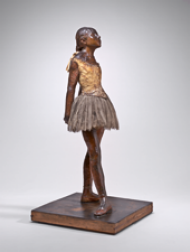Little Dancer Aged Fourteen
Technical Notes: Internal Construction
Technical Notes: Exterior Construction
Study in the Nude of Little Dancer Aged Fourteen (Nude Little Dancer)
Fourth Position Front, on the Left Leg
Modeling Movement: Degas’s Dancers
Introduction
These articles are taken from the catalog Edgar Degas Sculpture (National Gallery of Art, 2010). The National Gallery of Art holds the largest collection of wax sculptures by Edgar Degas in the world. This award-winning volume documents this collection and the groundbreaking technical research conducted by the Gallery’s conservation staff, along with new art historical scholarship. Written by Daphne Barbour, senior conservator, department of object conservation, National Gallery of Art; Suzanne G. Lindsay, adjunct associate professor in the history of art, University of Pennsylvania; and Shelley Sturman, senior conservator and head of the department of object conservation, Edgar Degas Sculpture is the last print catalog in the distinguished Collections of the National Gallery of Art Systematic Catalogue series, in which experts and scholars from around the world document the paintings, sculptures, and decorative arts in the Gallery’s collections. All subsequent National Gallery of Art collections catalogs will be published online in the new series National Gallery of Art Online Editions, which launched with Dutch Paintings of the Seventeenth Century in 2014. Edgar Degas Sculpture can be purchased in the National Gallery shops here.
In honor of the Degas’s Little Dancer exhibition, the National Gallery of Art is pleased to make this extensive research on three of its most popular sculptures available to the public online for the first time.

